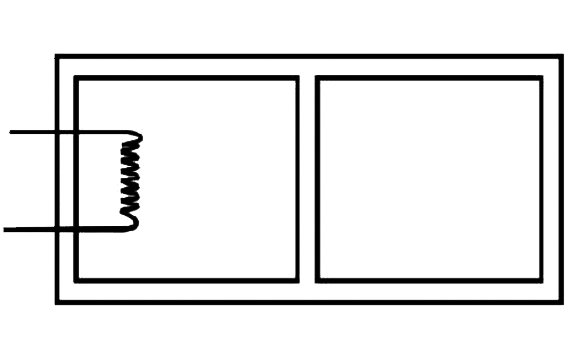An aluminium sphere of 20cm diameter is heated from 0∘C to 100∘C. Its volume changes by (given that the coefficient of linear expanison for aluminium (αAl=23×10−6/0C)Solution in Gujrati
28.9 cc
2.89 cc
9.28 cc
49.8 cc
The correct Answer is:A
ΔV=V0(3α)Δθ
=43(3.14)(10)3[3×23×10−6][100−0]
=28.9 cc
Topper's Solved these Questions
- GEOMETRICAL OPTICSBOOK - ALLEN CHAPTER - GEOMETRICAL OPTICSEXERCISE - EXERCISE - 05 (B)
58 Videos
- GEOMETRICAL OPTICSBOOK - ALLEN CHAPTER - GEOMETRICAL OPTICSEXERCISE - EXERCISE - 05 (B) (MCQ)
9 Videos
- GEOMETRICAL OPTICSBOOK - ALLEN CHAPTER - GEOMETRICAL OPTICSEXERCISE - EXERCISE - 04 (B)
15 Videos
- CURRENT ELECTRICITYBOOK - ALLEN CHAPTER - CURRENT ELECTRICITYEXERCISE - EX.II
66 Videos
- GRAVITATIONBOOK - ALLEN CHAPTER - GRAVITATIONEXERCISE - EXERCISE 4
9 Videos
Similar Questions
A vessel contains a mixture of one mole of oxygen and two moles of nitrogen at 300K. The ratio of the average rorational kinetic energy per O2 molecules to that per N2 molecules is
View SolutionLet ¯v,vrms and vp respectively denote the mean speed, the root-mean - square speed, and the most probable speed of the molecules in an ideal monoatomic gas at absolute temperature T. The mass of a molecule is m:-
View SolutionThe rectangular box shown in Fig has partition which can slide without friction along the length of the box. Initially each of the two chambers of the box has one mole of a mono-atomic ideal gas (λ=5/3) at a pressure P0, volume V0 and temperature T0. The chamber on the left is slowly heated by an electric heater. The walls of the box and the lead wires of the heater is negligible. The gas in the left chamber expands pushing the partition until the final pressure in both chambers becomes 243P0/32. Determine (i) the final temperature of the gas in each chamber and (ii) the work done by the gas in the right chamber.

View SolutionIn the Bohr's model of hy drogen atom, the electron moves around the nucleus in a circular orbit of radius 5×10−11m. Its time period is 1.5×10−16s. The current associated with the electron motion is:-
View SolutionAssertion : The difference in the value of acceleration due to gravity at pole and equator is proportional to square of angular velocity of earth.
Reason : the value of acceleration due to gravity is minimum at the equator and maximum at the pole.
View SolutionAn iron sphere of radius 10cm is at temperature , 10∘C. If the sphere is heated upto temperature 110∘C , find the change in the volume of the sphere coefficient of linear expansion of iron = 11×10−6.∘C−1
View SolutionA copper ring has a diameter of exactly 25mm at its temperature is 0∘C. An aluminium sphere has a diameter is exactly 25.05mm and its temperature it 100∘C. The sphere is placed on top of the rind and two allowed to come to thermal equilibrium. The ratio of the mass of the sphere and ring is
(given αcu=17×10−6.∘C−1αAl=2.3×10−5.∘C−1 specific heat of Cu is 0.0923cal/g∘C and for Al is 0.215cal/g∘C.
View SolutionAn aluminium sphere of 20cm diameter is headed from 0∘C to 100∘c. Its volume changes by (given that the coefficient of linear expanison for aluminium (αAl=23×10−6/0C)
View SolutionAn iron sphere has a radius of 10 cm at a temperature of 0∘C. Calculate the change in the volume of the sphere, if it is heated to 100∘C. Coefficient of linear expansion of iron =11×10−6.∘C−1.
View SolutionAn iron sphere has a radius of 10 cm at a temperature of 0^(@)C . Calculate the change in volume of the sphere if it is heated to 100^(@)C . Given alpha_(Fe) = 1.1 xx 10^(-6).^(@)C^(-1)
View SolutionA circular hole in an aluminium plate has a diameter of 4cm at 0^(@)C . What is its diameter when the temperature of the plate is raised to 100^(@)C ? (Linear expansivity of aluminium =23xx10^(-6)K^(-1) )
View Solution20 cm व्यास के ऐलुमिनियम के एक गोले को 0∘C से 100∘C तक गर्म किया जाता है। यदि ऐलमिनियम का रैखिक असार गुणाक α=23×10−6∘C−1 है तो इसके आयतन में परिवर्तन होगा :
View Solutionव्यास 20 सेमी के एक एल्युमिनियम गोले को 0∘C से 100∘C तक गर्म किया जाता है |इसके आयतन में परिवर्तन होगा |(दिया है : ऐल्युमिनियम का रेखीय प्रसार गुणांक α=23×10−6 प्रति .∘C)
View SolutionAn aluminium sphere of diameter 20 cm is heated from 0^(@)C " to " 100^(@)C . What will be its change in volume? Coefficient of linear expansion of aluminium =23 times 10^(-6@)C^(-1) .
View SolutionAn aluminium sphere of diameter 10 cm is submerged in glycerine of density 1.26g*cm^(-3) " at " 20^(@)C . Calculate the change in apparent weight of the sphere when the glycerine is heated to 100^(@)C . Coefficient of volume expansion of glycerine =5 times 10^(-4@)C^(-1) and that of linear expansion of aluminium =2.5 times 10^(-6@)C^(-1) .
View SolutionAn aluminium sphere of 20 cm diameter is heated from ""^(@)C" to "100^(@)C . Its volume changes by (given that coefficient of linear expansion for aluminium alpha _(Al)= 23 xx 10^(6)//^(@)C) .
View Solution
